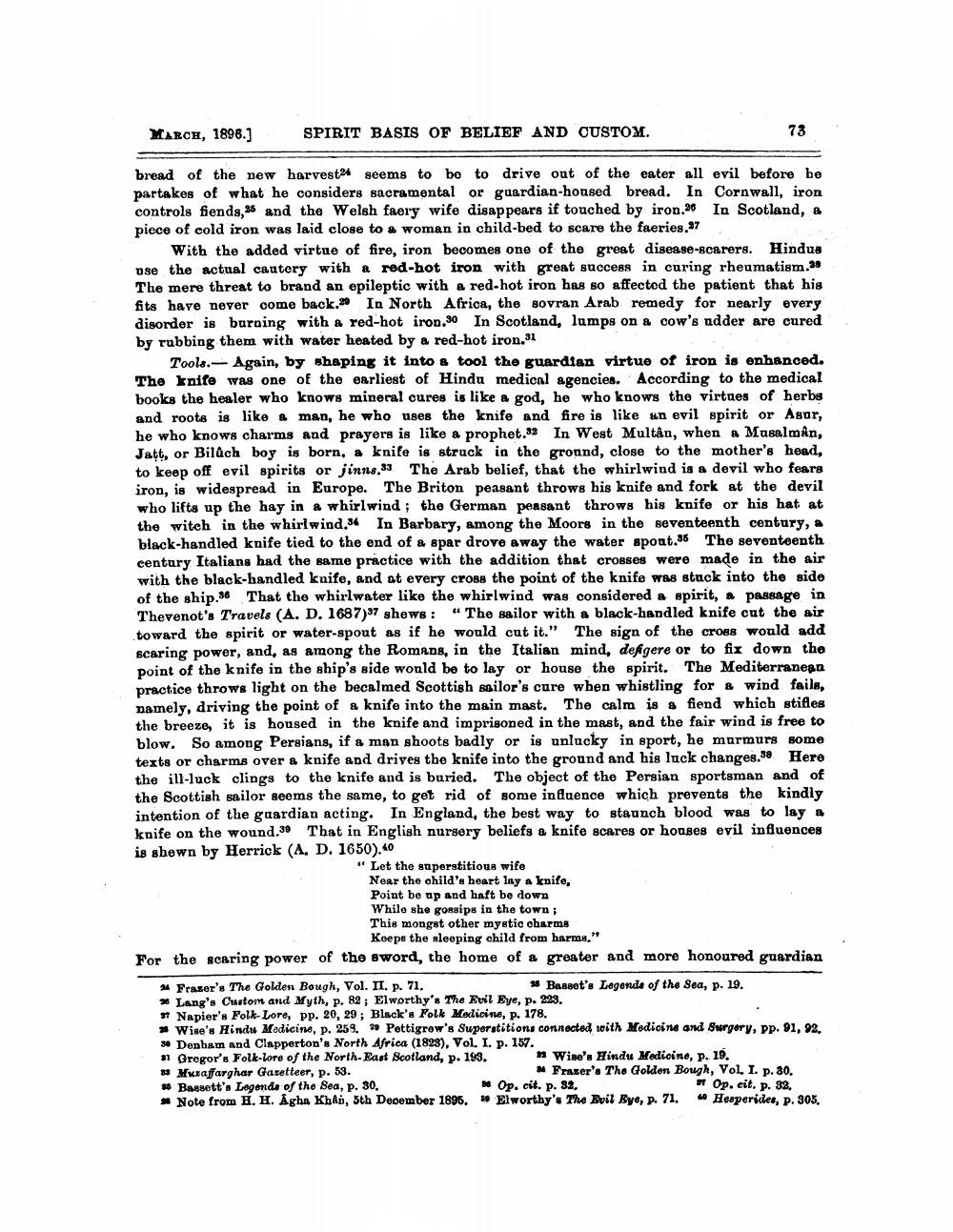________________
SPIRIT BASIS OF BELIEF AND CUSTOM.
MARCH, 1896.]
bread of the new harvest24 seems to be to drive out of the eater all evil before be partakes of what he considers sacramental or guardian-housed bread. In Cornwall, iron controls fiends,25 and the Welsh faery wife disappears if touched by iron.26 In Scotland, a piece of cold iron was laid close to a woman in child-bed to scare the faeries.37
With the added virtue of fire, iron becomes one of the great disease-scarers. Hindus use the actual cautery with a red-hot iron with great success in curing rheumatism.20 The mere threat to brand an epileptic with a red-hot iron has so affected the patient that his fits have never come back. In North Africa, the sovran Arab remedy for nearly every disorder is burning with a red-hot iron.30 In Scotland, lumps on a cow's udder are cured by rubbing them with water heated by a red-hot iron.31
73
Tools. Again, by shaping it into a tool the guardian virtue of iron is enhanced. The knife was one of the earliest of Hindu medical agencies. According to the medical books the healer who knows mineral cures is like a god, he who knows the virtues of herbs and roots is like a man, he who uses the knife and fire is like an evil spirit or Asur, he who knows charms and prayers is like a prophet.32 In West Multân, when a Musalmân, Jatt, or Bilach boy is born, a knife is struck in the ground, close to the mother's head, to keep off evil spirits or jinns.33 The Arab belief, that the whirlwind is a devil who fears iron, is widespread in Europe. The Briton peasant throws his knife and fork at the devil who lifts up the hay in a whirlwind; the German peasant throws his knife or his hat at the witch in the whirlwind. In Barbary, among the Moors in the seventeenth century, a black-handled knife tied to the end of a spar drove away the water spout.35 The seventeenth century Italians had the same practice with the addition that crosses were made in the air with the black-handled knife, and at every cross the point of the knife was stuck into the side of the ship.36 That the whirlwater like the whirlwind was considered a spirit, a passage in Thevenot's Travels (A. D. 1687)37 shews: "The sailor with a black-handled knife cut the air toward the spirit or water-spout as if he would cut it." The sign of the cross would add scaring power, and, as among the Romans, in the Italian mind, defigere or to fix down the point of the knife in the ship's side would be to lay or house the spirit. The Mediterranean practice throws light on the becalmed Scottish sailor's cure when whistling for a wind fails, namely, driving the point of a knife into the main mast. The calm is a fiend which stifles the breeze, it is housed in the knife and imprisoned in the mast, and the fair wind is free to blow. So among Persians, if a man shoots badly or is unlucky in sport, he murmurs some texts or charms over a knife and drives the knife into the ground and his luck changes. Here the ill-luck clings to the knife and is buried. The object of the Persian sportsman and of the Scottish sailor seems the same, to get rid of some influence which prevents the kindly intention of the guardian acting. In England, the best way to staunch blood was to lay a knife on the wound.39 That in English nursery beliefs a knife scares or houses evil influences is shewn by Herrick (A. D. 1650).40
38
"Let the superstitious wife
Near the child's heart lay a knife, Point be up and haft be down While she gossips in the town;
This mongst other mystic charms Keeps the sleeping child from harms."
For the scaring power of the sword, the home of a greater and more honoured guardian
83 Muzaffarghar Gazetteer, p. 53.
ss Bassett's Legends of the Sea, p. 30.
24 Frazer's The Golden Bough, Vol. II. p. 71.
25 Basset's Legends of the Sea, p. 19. Lang's Custom and Myth, p. 82; Elworthy's The Evil Eye, p. 223. Napier's Folk-Lore, pp. 20, 29; Black's Folk Medicine, p. 178.
Wise's Hindu Medicine, p. 259. 29 Pettigrew's Superstitions connected with Medicine and Surgery, pp. 91, 92. 30 Denham and Clapperton's North Africa (1823), Vol. I. p. 157. 31 Gregor's Folk-lore of the North-East Scotland, p. 193.
Note from H. H. Agha Khan, 5th December 1895. Elworthy's The Evil Eye, p. 71.
Wise's Hindu Medicine, p. 19.
34 Frazer's The Golden Bough, Vol. I. p. 30. be Op. cit. p. 32.
Op. cit. p. 32. Hesperides, p. 305,




